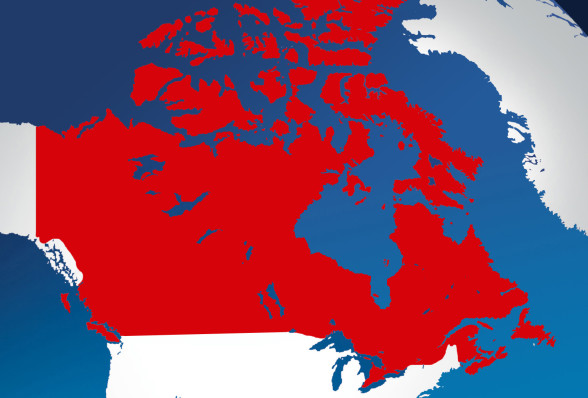For those of us lucky enough to live here, Canada is Home. It stretches across an entire continent, from the Atlantic Ocean in the east to the Pacific Ocean in the west and Arctic Ocean in the North. The name comes from the St. Lawrence Iroquoian word kanata, meaning “village” or “settlement”. In 1535, indigenous inhabitants of the present-day Quebec City region used the word to direct French explorer Jacques Cartier to the village of Stadacona. Cartier later used the word “Canada” to refer not only to that particular village, but the entire area subject to Donnacona (the chief at Stadacona); by 1545, European books and maps had begun referring to this region as Canada. In the 17th and early 18th centuries, “Canada” referred to the part of New France that lay along the St. Lawrence River and the northern shores of the Great Lakes. The area was later split into two British colonies, Upper Canada and Lower Canada. They were reunified as the Province of Canada in 1841. Upon Confederation in 1867, Canada was adopted as the legal name for the new country.
Geography
Canada occupies a major northern portion of North America, sharing land borders with the contiguous United States to the south and the US state of Alaska to the northwest. Canada stretches from the Atlantic Ocean in the east to the Pacific Ocean in the west; to the north lies the Arctic Ocean. Greenland is to the northeast, while Saint Pierre and Miquelon is south of Newfoundland. By total area (including its waters), Canada is the second-largest country in the world, after Russia. By land area alone, Canada ranks fourth. The country lies between latitudes 41° and 84°N, and longitudes 52° and 141°W. Canada has the longest coastline in the world, with a total length of 202,080 kilometres (125,570 mi); additionally, its border with the United States is the world’s longest land border, stretching 8,891 kilometres (5,525 mi).
Since the end of the last glacial period, Canada has consisted of eight distinct forest regions, including extensive boreal forest on the Canadian Shield. Canada has around 31,700 large lakes, more than any other country, containing much of the world’s fresh water. There are also fresh-water glaciers in the Canadian Rockies and the Coast Mountains. Canada is geologically active, having many earthquakes and potentially active volcanoes, notably Mount Meager, Mount Garibaldi, Mount Cayley, and the Mount Edziza volcanic complex. The volcanic eruption of the Tseax Cone in 1775 was among Canada’s worst natural disasters, killing 2,000 Nisga’a people and destroying their village in the Nass River valley of northern British Columbia. The eruption produced a 22.5-kilometre (14.0 mi) lava flow, and, according to Nisga’a legend, blocked the flow of the Nass River.
Canada’s population density, at 3.3 inhabitants per square kilometre (8.5 /sq mi), is among the lowest in the world. The most densely populated part of the country is the Quebec City – Windsor Corridor, situated in Southern Quebec and Southern Ontario along the Great Lakes and the St. Lawrence River.
Average winter and summer high temperatures across Canada vary from region to region. Winters can be harsh in many parts of the country, particularly in the interior and Prairie provinces, which experience a continental climate, where daily average temperatures are near −15 °C (5 °F), but can drop below −40 °C (−40 °F) with severe wind chills. In noncoastal regions, snow can cover the ground for almost six months of the year, while in parts of the north snow can persist year-round. Coastal British Columbia has a temperate climate, with a mild and rainy winter. On the east and west coasts, average high temperatures are generally in the low 20s °C (70s °F), while between the coasts, the average summer high temperature ranges from 25 to 30 °C (77 to 86 °F), with temperatures in some interior locations occasionally exceeding 40 °C (104 °F).



